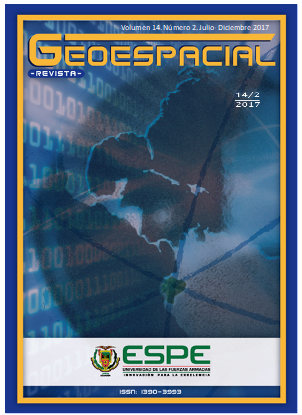EVALUACIÓN DE SUSCEPTIBILIDAD A DESLIZAMIENTOS MEDIANTE LÓGICA FUZZY Y TÉCNICAS DE EVALUACIÓN MULTICRITERIO EN LA AVENIDA SIMÓN BOLÍVAR, QUITO
Contenido principal del artículo
Resumen
Los deslizamientos son uno de los fenómenos más recurrentes en el Distrito Metropolitano de Quito (DMQ), debido a sus condiciones naturales e intervención antrópica. Consecuencia de ello, la infraestructura vial ha sido mayoritariamente afectada, por lo que la presente investigación propone la evaluación de susceptibilidad a deslizamientos mediante lógica Fuzzy y técnicas de evaluación multicriterio en Sistemas de Información Geográfica (SIG) de la Avenida Simón Bolívar. Basado en el principio “Hoy y el pasado son claves para el futuro”; se localizaron deslizamientos mediante la interpretación de ortofotos y trabajo en campo, con un total de 45 zonas afectadas. En base a las características de deslizamientos históricos, fotointerpretados e investigaciones anteriores, se utilizaron como factores causales: topografía, geología, litología, precipitación, red hídrica, cobertura vegetal, entre otros. Cada factor fue procesado, analizado y estandarizado de acuerdo a su relación con el desencadenamiento de deslizamientos, mediante una función de pertenencia sinusoidal que asigno a cada elemento del universo un grado de pertenencia de 0 a 1 al conjunto difuso. El mapa de susceptibilidad a deslizamientos fue obtenido de la combinación de factores causales mediante álgebra de mapas y técnicas de ponderación, donde se incluyen: el proceso de análisis jerárquico (AHP) y combinación lineal ponderada (WLC), cuya validación consideró las localizaciones de deslizamientos inventariados. De acuerdo con el mapa de susceptibilidad, 5% del área de estudio directa posee susceptibilidad crítica, 19% alta, 58% media y 18% baja. La calidad del resultado se validó de acuerdo a su desviación estándar y valor de ajuste, siendo 0,162 y 83,80%, respectivamente.
Detalles del artículo
Sección
Artículos Técnicos
Acceso a archivos
Los artículos publicados en la Revista Geoespacial se sujetan a las directrices de OPEN ACCES, en cuanto a la apertura de su contenido hacia todos los visitantes del sitio.
Derechos que conserva el autor:
El autor conserva los derechos morales de publicación
Cesión de derechos a autores:
Se cede los derechos de citas, referencias y temas relacionados con aspectos académicos y de investigación
Cómo citar
EVALUACIÓN DE SUSCEPTIBILIDAD A DESLIZAMIENTOS MEDIANTE LÓGICA FUZZY Y TÉCNICAS DE EVALUACIÓN MULTICRITERIO EN LA AVENIDA SIMÓN BOLÍVAR, QUITO. (2020). Revista Geoespacial, 14(2), 1-20. https://journal.espe.edu.ec/ojs/index.php/revista-geoespacial/article/view/1604

